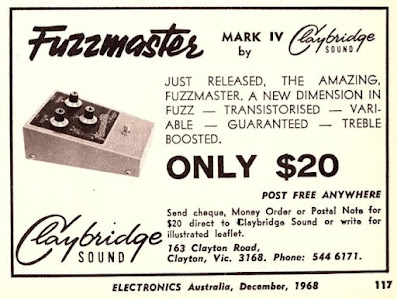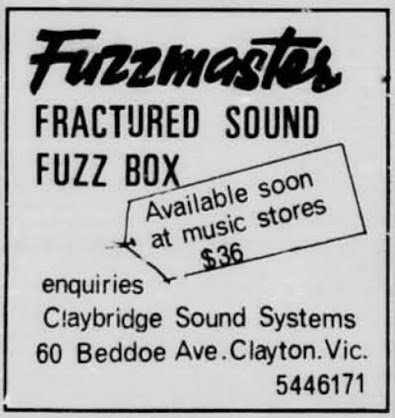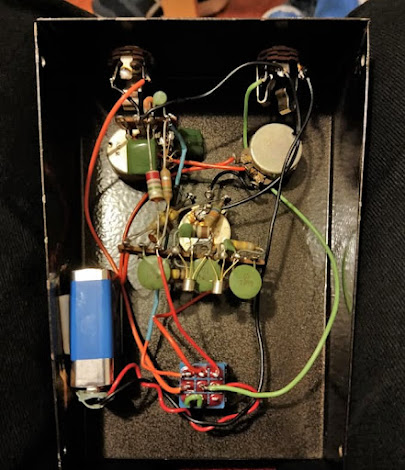☟
After posting the previous article on the rare 1960's Australian fuzz, the Claybridge Fuzzmaster, I was contacted by quite a few people who wanted to help dig up more info on this otherwise forgotten brand. The results of these extremely kind persons will come in Part 3 of this series...
In the meantime, I spent the last week going through 6 years worth of magazines and periodicals looking for any additional advertisements that would help paint a more accurate story and timeline. And OHHHHHH SHIT!!!! did I find them. :)
So get ready, we're about to go year by year (and sometimes week by week) into the tale of Claybridge Sound and Ralph Bridges, the Australian Fuzzmaster.
The very first advertisement to pop up was on April 27th 1966. It was in an issue of the recently birthed Go-Set Magazine, and was a simple text that appears to be selling "Fuzz Boxes" for $20 a piece that come with a foot switch, effect control, and a 15' lead (which I am taking to mean a hardwired cable).
Here are two different scans of that ad:
The second ad came just a few weeks later, on May 4th 1966. A couple things to notice about this; in addition to the price going up $4, and the amount of setup time increasing 6 seconds (lol), the biggest change has to be the extra control; going from a single Effect control in the previous ad to Effect AND Volume. But it is unclear is if this means it actually went from a 1-knob to a 2-knob pedal, or if he was just playing around with the copy of each ad to find something that worked best...
The next ad comes just a couple weeks later, on May 16th 1966.
To me, this one is really important as it implies a few things; one, this is a new and updated design from the Fuzz Boxes that were available up to that point. Two, this is the first time you will see mention of an "inbuilt treble boost" which makes sense when you look at the Fuzzmaster circuit. Three, this description states that there are controls for Volume and Fuzz. That's interesting because every version of the Fuzzmaster actually has three controls; Volume, Fuzz, and Treble.
All of this implies a 2-knob fuzz, with a 15' hardwired cable, that possibly had what was to become the original Fuzzmaster circuit.
So is this the 2nd version of Ralph Bridges' fuzz design? And is this what he would later consider to be the "Mark II" Fuzzmaster???
The next two ads come about a month apart, in July and August of 1966. This is the first, and definitely not the last time we see Bridges' leaning toward classic sales tactics in his copy. Using scarcity to push that there are only a few left before he increases the price! and that "over 100 groups now use this model".
The one thing I find most interesting about these two is that they seem to imply that he had already finished designing what was to become the Fuzzmaster, and knew it was going to be released within a couple of months.


In the middle of this marketing strategy for the Fuzzmaster release, Bridges takes out another ad, but this time with an emphasis on the Claybridge amplifiers he has for sale/rent.
Also, I'm pretty sure he just took his business card and submitted it as an ad. Genius!
A week later, on August 14th 1966, we get to see the Fuzzmaster font for the first time, announcing that the new pedal will be available soon for the previously promised $36.
Just one month later we finally get to see the Fuzzmaster pedal in all its glory!
A New Dimension in Fuzz Effects
There is so much hyperbole packed into this tiny advert, that I'm just gonna let you peruse it yourself and enjoy.
Oddly enough, after all the hype, it wouldn't be another 7 months until we saw a new advertisement from Claybridge. The above ad was actually the only one I was able to find that mentioned that first version of the Fuzzmaster.
Also, let's talk about that.
The earliest ad so far was from April of 1966, describing a fuzz box with a single knob and a hardwired cable. The next ad, coming in May of 1966, described a fuzz box with two knobs, but otherwise the same as the first. The third ad describes a new and improved fuzz box, with two knobs and the addition of an inbuilt treble booster. And finally we come upon the releases of the Fuzzmaster. A pedal that clearly has 3 knobs, can be used as a treble booster and no longer has a hardwired cable (a 15 ft. lead is never mentioned again).
So what does this all mean? To me, it means that the Fuzzmaster is potentially what Ralph Bridges actually considers to be the "Mark III" of his fuzz designs.
But, let's move on and you can decide for yourself...
Ok, so the next two ads were a bit of a surprise for me. In what seems to be yet another attempt at marketing his products differently, in 1967 Claybridge becomes all about Kits. And from the looks of this ad from March of 1967, for just $10 you too can build a Fuzzmaster of your very own!
The interesting distinction of the below ad, from July of 1967, is that it also mentions a kit for a treble booster! We will see a production version later on, but up until now we hadn't heard about one from Claybridge at all. Additionally, Bridges drops "Systems" from the company name, simply going with Claybridge Sound.
This next ad, coming in October of 1967, is pushing kits for amplifiers and PA systems, and is also the unintentional announcement of a new location for the company, going from 60 Beddoe Ave. and moving right up the street to 163 Clayton Road.
While 1967 was a rather slow year for Claybridge advertisements, 1968 was just weird.
For almost every weekly issue of Go-Set Magazine that year Claybridge ran ads like the two you see below; rather unremarkable and simply stating that they're an audio equipment rental and sales service. No mention of Fuzz pedals at all would show up again until the Fall.


On October 23rd 1968 we get introduced to the Fuzzmaster Mark IV for the first time!
After 10+ months of mindless text-filled ads we got this monstrosity of sloppily laid fonts, big ridiculous proclamations, and a somewhat confusing announcement about the newest member of the Claybridge fuzz family. Also, the price went down $16 from the previous model. Which was most likely the reason for the less complicated "update" to an already existing pedal.
Later that December we again see an ad announcing the new Fuzzmaster Mark IV, which also marks the first time Bridges runs with Electronics Australia magazine.
Just a couple of weeks later, December 18th 1968, Bridges goes with this ad below; that again features the new Fuzzmaster Mark IV, but also mentions the amplifiers and general PA equipment they have for rent/sale. Additionally he tries his hand at "art". :)

Apparently he was on a bit of a roll by the last week of 1968, and this ad actually made it into a national publication...

And then we enter into 1969. The most prolific and ridiculous year for Claybridge advertisements.
I left out any redundant ads from this section, but I think you'll have no problem painting your own picture of what business must have been like for Bridges at this time.
The first thing we see is this awesome photo ad that shows not only the Fuzzmaster Mark IV, but also the wide range of amplifiers, cabs, mixing boards, microphones, etc. that Claybridge had to offer.

Then a month later, in April of 1969, we see what is definitely my favorite ad of the whole bunch. Clearly Bridges was getting help with graphic design at this point, and more clearly he's trying to capture what Spring of 1969 in Australia was all about, but look how awesome this is! If it was a shirt, I would 100% wear it. ;)
For Way Out Sound
For WILD Sax Sounds
Long Sustain
Also, Claybridge was really pushing that tagline by this time, "For Prestige Sound". Which while I don't really know what that's supposed to mean, it does sound nice.
In July of 1969 he releases this 4 part ad campaign, spread over 4 separate pages of Electronics Australia magazine, to announce their display at the upcoming Melbourne Audio & Visuals Fair.
I would love to find photos of this! I'm picturing a weird 60's proto NAMM with electronics geeks and audio nerds hanging out everywhere. You know, like today's NAMM!
All four of these ads are the most professional and striking ones Claybridge ran in the 60s. The other thing I've noticed is that I was not able to find any version of these without the "Stop Press" stripe added to them; meaning that Bridges was probably doing even more advertising in different publications that I have yet to track down.
Then in December of 1969 Claybridge released this double-full page ad that probably has the best photos of not only the amplifiers and PA's they had to offer, but also an echo/tremolo unit, the Wildcat version of the Fuzzmaster makes its first appearance, and this is also the first time we see what I call the "Pick" logo, that appears on the production version of the Wildcat.
This is most likely a condensed version of the Claybridge Catalogue, but obviously there's no way of knowing until I find an actual copy.
The Wildcat announcement surprised me, and as the timeline goes, will be the major correction to the previous article. I thought for sure it came before the Mark IV, but I feel like Claybridge had done well for at least part of 1969, and with that growing popularity Bridges decided to re-release the original 3 transistor Fuzzmaster design. The overall build seems a bit more cost/time effective, and while it was still not as expensive as the original Fuzzmaster, he was able to sell this at an increase of $7 over the Mark IV.
As for the name change, we can see from all this advertising that Bridges was constantly trying something different to attract a bigger audience and sell his products. I haven't mapped out the circuits for both pedals, but my hunch is that they are very very similar in design.
Well, after that big push in 1969 we don't see another ad pop up until July of 1970 for a "Monster Catalogue" (which I have to find!) that shows just about everything from the previous ad but all condensed to a single image. *edited for size
Again Claybridge goes cold on the advertisements, this time for almost a year, and the final ad (posted in the previous article) came out in March of 1971. It's an announcement of the Grand Opening of yet another new location, a new logo, and a new name "Claybridge Audio".
The most important part of this ad to me is the photo of the Treble Booster which we hadn't see until now. But there's no mention of a fuzz pedal anywhere, and Bridges is still offering discounts, and using hyperbole and scarcity to generate excitement for his brand.
After this, the ads disappear. It is possible that more came later on, but when it comes to the sources I was referencing, this was it.
Thank you to anyone who read this far and came along this nerdy journey with me. :)
A lot of conclusions can be made from looking through this mountain of ads and seeing the progression from week to week. I won't spoil this with my own conclusions, so I'll just leave it up to you to interpret it anyway you'd like.
What I will say is that the Claybridge Fuzzmaster is an amazing pedal that perfectly captures a moment in history, and learning more about its origin only increases the fuzzy joy it brings every time I plug into it.
*If you haven't read part 1, go here and check it out. There's photos of the actual units, gut shots, and all the pedal porn you could ask for.
Also, part 3 is coming soon...
Thanks for reading,
-ed




















.jpg)

















